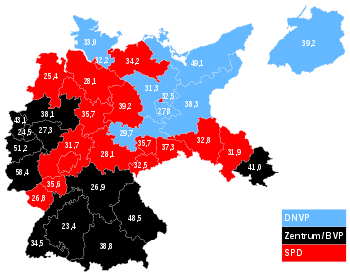German tariff of 1925
The German tariff of 1925 was a moderately protectionist law passed by the Reichstag that reintroduced tariffs on agricultural imports into Weimar Germany. It came into force on 1 September 1925.[1]

Under the Treaty of Versailles Germany was forbidden from setting its own tariff until 1925.[2] Tariffs on agricultural products had been abolished at the start of World War I to ensure a continuous food supply. There was great controversy over whether protectionism should be resumed for agriculture. Left-wing parties and those representing small peasants opposed protection, with the conservatives and those representing large landowners in favour.[3]
The election of December 1924 led to a coalition government under Hans Luther, with the protectionist DNVP supporting an agricultural tariff.[4] There also emerged a new solidarity bloc between industry and agriculture that favoured the restoration of protection.[5] Although the new tariff nominally restored tariff rates similar to the prewar duties on grain, the provisional rates during the transition period were lower: wheat was subject to a duty of 3.50 marks per quintal and rye to a duty of 3 marks.[6] However, from August 1926 wheat and rye were subject to a duty of 5 marks.[7] The tariff helped to moderate the fall in prices.[8]
Notes
- Tracy, p. 182.
- Tracy, p. 182.
- Tracy, p. 182.
- Gessner, p. 765.
- Gerschenkron, p. 116.
- Gerschenkron, p. 117.
- Gerschenkron, p. 117.
- Tracy, p. 182.
References
- Alexander Gerschenkron, Bread and Democracy in Germany (New York: Howard Fertig, 1966).
- Dieter Gessner, 'Agrarian Protectionism in the Weimar Republic', Journal of Contemporary History, Vol. 12, No. 4 (Oct., 1977), pp. 759-778.
- Michael Tracy, Government and Agriculture in Western Europe, 1880–1988 (London: Harvester Wheatsheaf, 1989).